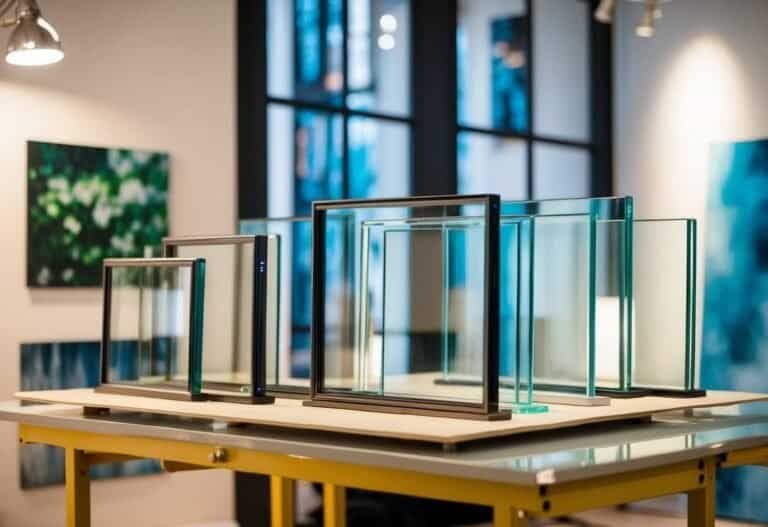Choosing the Right Glass for Your Art: Essential Factors for Preservation and Display
Choosing the right glass for your artwork is a crucial step in preservation framing. The glass you select can make a big difference in how your art looks and how long it lasts. Proper glazing protects artwork from harmful UV rays and reduces glare, helping to maintain its beauty and value over time.
There are several options available for framing glass, each with unique benefits. Regular glass blocks some UV light, but specialty glass can offer much more protection. UV-filtering glass is designed to shield artwork from fading caused by sunlight exposure. For pieces displayed in bright areas, reflection control glass can minimize glare and make details easier to see.
Acrylic is another option for framing artwork. It’s lighter than glass and less likely to break. Some acrylic options offer UV protection and glare reduction similar to specialty glass. The choice between glass and acrylic often depends on the size of the artwork and where it will be displayed.
Understanding Art Preservation

Proper art preservation involves protecting artwork from harmful elements while maintaining visual clarity. UV protection, glare reduction, and appropriate glazing materials play crucial roles in safeguarding and displaying art effectively.
The Role of UV Protection
UV protection is vital for preserving artwork. UV rays can cause fading, yellowing, and deterioration of pigments and materials. High-quality framing glass with UV filtering properties blocks up to 99% of harmful rays.
UV-protective glazing comes in various forms:
- Museum-grade glass
- UV-filtering acrylic
- Special coatings on regular glass
These options help extend the lifespan of paintings, photographs, and other light-sensitive pieces. Art collectors and museums often choose UV-protective glazing to maintain the value and integrity of their collections over time.
Clarity and the Viewing Experience
Clear visibility is essential for appreciating artwork fully. Anti-reflective coatings on glass reduce glare and reflections, allowing viewers to see the true colors and details of the piece.
Some advanced glazing options include:
- Museum glass with minimal reflectivity
- Optically-coated acrylic
- Non-glare glass for high-light environments
These materials enhance the viewing experience by reducing distractions and improving overall clarity. They make it easier to appreciate the artwork’s subtleties and textures.
Importance of Glazing Material
Choosing the right glazing material is crucial for both protection and presentation. Glass and acrylic are the two main options, each with unique benefits.
Glass:
- Traditional choice
- Scratch-resistant
- Heavier and more fragile
Acrylic:
- Lightweight and shatter-resistant
- Ideal for large pieces
- More prone to scratches
The choice depends on factors like artwork size, display location, and handling requirements. Some glazing materials combine multiple features, offering UV protection, clarity, and durability in one product.
Comparing Glass Types

When framing artwork, the type of glass you choose affects both protection and appearance. Different glass options offer varying levels of UV protection, clarity, and glare reduction.
Regular Glass vs. Conservation Glass
Regular glass is the most basic option for framing. It’s affordable but offers limited UV protection. Regular glass blocks about 45% of UV rays.
Conservation glass provides much better protection. It blocks up to 99% of harmful UV rays. This helps prevent fading and damage to artwork over time.
Conservation glass is clearer than regular glass. It has less of a greenish tint. This allows the true colors of the artwork to shine through.
For valuable or light-sensitive pieces, conservation glass is often the better choice. It costs more but offers superior long-term protection.
Premium Clear Glass Explained
Premium clear glass, also known as water white glass, offers exceptional clarity. It contains very low iron content, reducing the greenish tint found in regular glass.
This type of glass allows for true color representation. It’s ideal for showcasing vibrant or subtle hues in artwork.
Premium clear glass improves visibility while still offering protection. Many premium options include UV-filtering properties.
It’s more expensive than regular glass but can greatly enhance the viewing experience. For high-quality prints or original artwork, premium clear glass is worth considering.
Non-Glare Glass Features
Non-glare glass has a special coating or texture that reduces reflections. This makes it easier to view artwork in bright or variable lighting conditions.
The anti-reflective properties allow for better visibility of the artwork. Viewers can appreciate details without distracting glare.
Some non-glare glass options also offer UV protection. This combines the benefits of glare reduction and artwork preservation.
Non-glare glass is particularly useful in rooms with lots of windows or bright lighting. It’s also beneficial for pieces displayed in public spaces with varying light conditions.
Specialty Glass Options

Art collectors and framers have several advanced glazing options to protect and display artwork. These specialty glasses offer improved clarity, UV protection, and glare reduction compared to standard glass.
Anti-Reflective and Reflection Control Glass
Reflection control glass helps reduce glare, making it easier to view artwork in bright locations. This type of glass is ideal for pieces displayed in areas with direct sunlight or strong lighting.
Anti-reflective glass goes a step further by nearly eliminating reflections. It allows viewers to see the true colors and details of the artwork without distracting glare.
Both options protect against 99% of UV rays, helping prevent fading and damage over time.
Museum Glass Characteristics
Museum glass is considered the highest quality option for framing valuable artwork. It offers exceptional clarity, making the glass nearly invisible.
Key features of museum glass include:
- 99% UV protection
- Anti-reflective coating
- Exceptional clarity
This glass type is often used in museums and galleries to protect priceless pieces while providing an optimal viewing experience.
Optium Acrylic Selection
Optium acrylic is a high-end alternative to glass. It offers several benefits for framing artwork:
- Lighter weight than glass
- Shatter-resistant
- Anti-static properties to repel dust
Optium acrylic also provides excellent UV protection and anti-reflective properties. It’s a popular choice for large pieces or artwork that may be shipped or moved frequently.
While more expensive than standard glass, Optium acrylic offers superior protection and clarity for valuable artwork.
Factors to Consider When Choosing Glass

Selecting the right glass for your art involves evaluating several key elements. These factors impact the appearance, protection, and longevity of your artwork display.
Analyzing Aesthetic Appeal
The visual quality of glass greatly affects how artwork is perceived. Clarity is crucial for showcasing art accurately. Regular glass can create glare and reflections, potentially distorting the view.
Anti-reflective glass reduces these issues, allowing viewers to focus on the art itself. Some types even appear invisible, creating an unobstructed view.
Color neutrality is another important aspect. Some glass has a slight green tint, which can alter the artwork’s colors. Opting for low-iron glass ensures a clearer, more neutral appearance.
Determining Durability and Strength
The strength of glass is vital for protecting valuable artwork. Tempered glass offers increased durability and safety. If broken, it shatters into small, less dangerous pieces.
Laminated glass consists of layers bonded together with a plastic interlayer. This type remains intact if broken, providing excellent protection for artwork.
For high-traffic areas or large pieces, considering shatter-resistant options is wise. These glasses offer peace of mind against accidental damage.
UV protection is crucial for preserving artwork. Some glasses block up to 99% of harmful UV rays, preventing fading and deterioration over time.
Considering Thickness and Weight
Glass thickness affects both the appearance and practicality of framed art. Thinner glass (2mm-3mm) is lighter and less noticeable but offers less protection.
Thicker glass (4mm-6mm) provides better security and insulation. It’s ideal for larger pieces or those in busy areas.
Weight is an important consideration, especially for hanging artwork. Heavier glass requires stronger frames and mounting hardware.
Balancing thickness with weight is key. Too thick, and the glass may overpower the art. Too thin, and it might not offer adequate protection.
Acrylic Glazing Advantages

Acrylic glazing offers several key benefits for protecting artwork. It combines durability, safety, and conservation features that make it a popular choice for framing.
Shatter Resistance and Safety
Acrylic glazing is highly shatter-resistant, making it a safer option than glass. This quality is especially important for large frames or pieces in high-traffic areas.
If broken, acrylic doesn’t shatter into sharp pieces. It cracks or breaks into larger, duller chunks. This reduces the risk of injury.
Acrylic is also much lighter than glass. This makes it easier to handle and hang large frames safely. The lightweight nature puts less stress on frame joints and hanging hardware.
UV Filtering Capabilities
Acrylic glazing excels at blocking harmful UV rays. Many acrylic options filter out 99% of UV light.
This UV protection helps preserve artwork. It prevents fading, yellowing, and other light damage to paintings, photographs, and documents.
Standard clear acrylic typically blocks about 66% of UV rays. For maximum protection, specially treated UV-filtering acrylic is available.
The UV-blocking properties of acrylic don’t diminish over time. This provides long-lasting protection for valuable or irreplaceable pieces.
Conservation Clear Acrylic Benefits
Conservation clear acrylic offers the highest level of protection for artwork. It combines UV filtering with other preservation features.
This premium acrylic blocks 99% of UV rays. It also reduces glare and reflection, allowing artwork to be viewed more clearly.
Conservation clear acrylic is optically pure. It doesn’t distort colors or add a tint to the artwork beneath.
Many conservation acrylics have anti-static properties. This prevents dust from clinging to the surface, keeping artwork cleaner.
The clarity and protective qualities of conservation acrylic make it ideal for valuable or historically significant pieces. Museums and art galleries often use this type of glazing.
Practical Applications

Choosing the right glass is crucial for preserving and displaying various types of artwork. The proper glass selection can enhance visual clarity while providing essential protection.
Framing Limited Edition Prints
Limited edition prints require special care to maintain their value and appearance. UV-protective glass is essential to prevent fading and discoloration over time.
For prints with intricate details or vibrant colors, museum-quality glass offers superior clarity. This type of glass reduces glare and reflection, allowing viewers to appreciate the artwork fully.
Anti-static glass is recommended for prints with delicate surfaces, such as charcoal or pastel. It helps repel dust and prevents the artwork from sticking to the glass.
Protecting Original Works of Art
Original artworks demand the highest level of protection. Conservation-grade glass blocks up to 99% of UV rays, safeguarding the piece from light damage.
For oil paintings or textured works, spacers can be used to create distance between the art and the glass. This prevents potential damage from contact and allows air circulation.
In humid environments, consider using glass with anti-microbial properties to inhibit mold growth. This is particularly important for watercolors and other moisture-sensitive mediums.
Custom Framing Family Heirlooms
Family heirlooms often have both sentimental and historical value. Non-glare glass is ideal for documents or photographs that may be displayed in areas with variable lighting.
For three-dimensional objects, such as medals or fabric items, museum-quality acrylic can be a safer alternative to glass. It’s lighter and less prone to shattering.
When framing delicate items like antique lace or aged paper, using glass with UV protection and anti-static properties helps preserve the item’s integrity. This combination guards against both light damage and dust accumulation.








